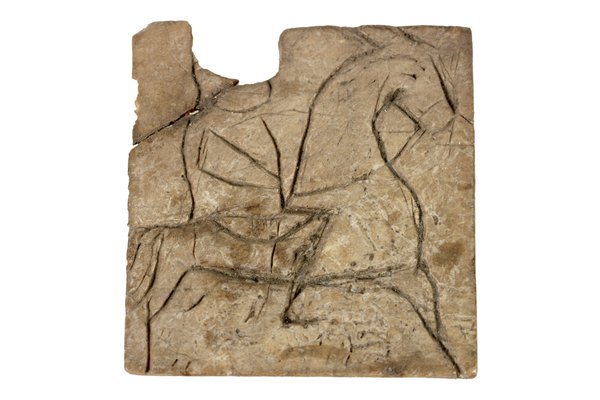Bone plaque Inlay Activity
This activity is aimed at schools & families to help discover the wonder of Roman objects in our collection.
Bone plaque Inlay

This bone plaque engraved with a man on horseback was probably used as decoration on a wooden box. The grooves may have been filled with coloured wax to make the image stand out.
The art of carving bone dates back to prehistoric times and involves the carving of animal bones, especially antler and horn. Bone was used to make useful objects such as sewing needles, weaving implements, combs, pins for clothing and women's hair, game pieces and jewellery, as well as inlayed decoration for furniture and boxes, like the bone plaque above. The Carvings on bone could vary from very intricate and detailed designs to a very basic engraving like this man on a horse.
Inlay is a decorative technique used to create an ornamental design, pattern, or scene on something by inserting pieces of contrasting, or coloured materials into it. Inlay during Roman times can be found on objects, floors, walls, or furniture. The materials used to make inlay can range from bone, glass, and pottery to stone, shells, metal, and wood.
Activities
Take a good look at this bone plaque
What do you see, notice and wonder about it? Do you think it was etched by an artist or by the owner of the box? Who might have owned such a box with an inlay showing a man on horseback? What might they have kept inside it? The riders face is missing from the plaque, can you imagine what they might have looked like?
Now it’s your turn
Using materials you have on hand, recreate this picture adding the riders face and head. Do you think this man was a soldier going into battle? Add the clothing and armour he might have been wearing. Next, why not design your own box with ornamental inlay. What picture or design will you put on your box?
Top Tip: Try using a pizza box, jewellery box, cereal box or even a tissue box. You can cut your design out of old cards, magazines, or draw it on paper and glue it onto your box.
Learning Extension
Many objects made of bone have been found by archaeologists at Arbeia Roman Fort. Take a look at the object below. Can you guess what it is and who the figure is? Who do you think might have owned it? Where in the fort do you think it might have been found? What type of bone do you think it is made from? Do you think this was an unusual find?

This object is the handle of a folding knife, with part of the iron blade visible at the back. It is made out of ivory from Africa, and would have been an expensive item to buy. It is in the shape of a Murmillo or Secutor gladiator. The two types are distinguished by their type of helmet. This gladiator wears a large rectangular shield, thick cloth padding and a metal leg-guard on his left leg and a cloth arm-guard on his right arm. He has a short sword. He would usually fight against a Thraex, who wore padded trousers with thigh-length metal leg-guards, an arm-guard and a helmet with a wide brim, with a small rectangular shield and a curved sword or a Hoplomachus, who dressed like a Thraex but used a round shield, a straight sword and a spear.
What is unusual about this knife-handle? The only gladiator to fight without a helmet was the Retiarius, who was armed with a net and trident. Almost every image of the other types of gladiator shows them wearing their elaborate helmets. Why do you think this gladiator is not wearing a helmet?
More online activities to enjoy
Unfortunately at this current time we can not offer our full family programmes in the museums but we have created lots of online learning activities for you to enjoy.
More online activities from our venues:
Segedunum Roman Fort
Find out about Marvellous Mondays : Home from Segedunum Collections.
South Shields Museum & Art Gallery
Take part in Take One Treasure Challenge - activities inspired by the museum collection.




